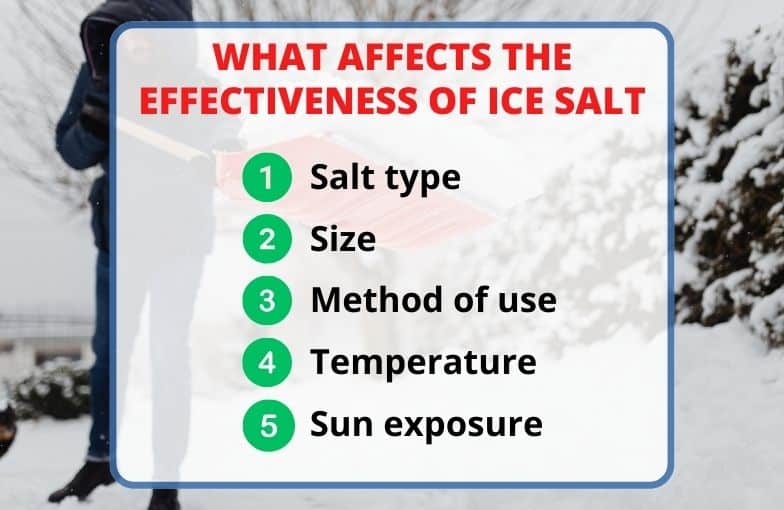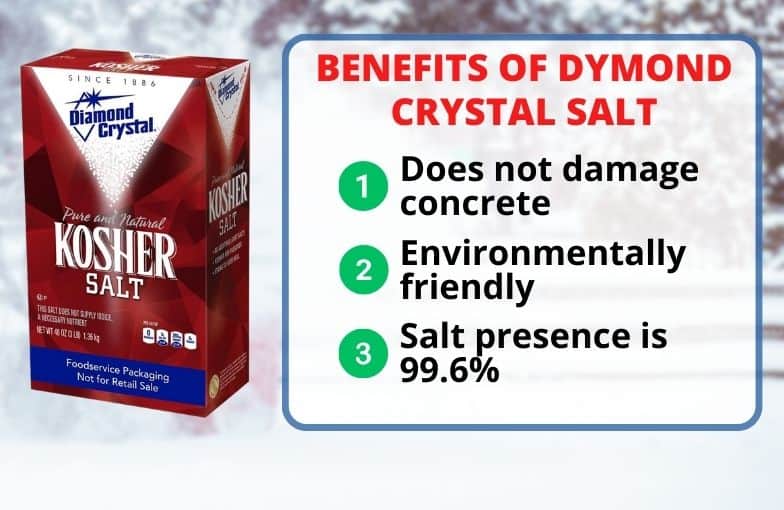Can You Use Water Softener Salt to Melt Ice? If you are looking for an answer to this query, you have come to the right place. Many people face the problems of icy ramps, driveways, and stairs wondering if the softener salt can help. To clear your doubts, I invite you to check out this informative guide till the end. So without any delays, let’s head on to the details!
Table of Contents
Can You Use Water Softener Salt to Melt Ice? Quick Answer
To provide a swift response, it is confirmed that water softener salt can be used to melt ice. The presence of Sodium Chloride (NaCl) in it lowers the freezing point of the water and helps with de-icing. Compared to other such products, a water softener salt offers the following perks:
- Cheaper;
- More effective;
- Less corrosive;
- Widely available.
However, the above information is just the tip of the iceberg. Continue reading to learn more about the pros and cons of the salt softener. Also, get insights into other suitable alternatives used as ice-melting agents. Let’s explore deeper into this guide!
A Sneak Peek Into Water Softener Salt Melt Ice
There are 4 types of water softener salt in terms of composition:
- Sodium Chloride (NaCl);
- Potassium Chloride (KCl);
- Magnesium Chloride (MgCl);
- Calcium Chloride (CaCl2).

When these salts are thrown on the ice, they break down into ions, such as sodium or chloride. These ions interfere with the water molecules in the ice and break their bonds. In this way, ice is melted.
Using Water Softener Salt Pellets for De-Icing: Is It Safe?
There is no harm in using water softener salt pellets as a melting agent. The combination of NaCl and resin beads work as catalytic agents and speed up the deicing process.

In fact, when compared to other ice-melting agents, such as calcium chloride, it performs better due to its less corrosive properties.
Using Softener Salt For Driveways
In snowy areas such as California or New Hampshire, people often face the issue of ice accumulation on the driveways. To handle this issue effectively, you can use water softener salt. Follow the given steps:
- Step 1: Start by applying a thin layer of salt to the affected area. You should use 1 pound of salt for every square foot of ice.
- Step 2: In case of larger icy areas, spread the salt slowly to allow time for it to melt completely.
- Step 3: You can also add a pinch of table salt to speed up the process.
Now that we have learned about water softener salt, let’s head on to explore its positive and negative aspects.
Pros of Using Softener Salt
Listed below are some perks of using water softener salt. Let’s check them out:
- Pocket Friendliness: Compared to other ice-melt options, the softener salt is cheaper. It breaks down more ice molecules, thus requiring less amount and making it an affordable option.
- Accessibility: It is widely stocked at physical and online retailers, reducing the possibility of shortages even during peak winter demand.
- Efficiency: Salt reduces the freezing point of water, which efficiently melts ice. In fact, water softener salt can melt snow with temperatures ranging between -25°F to 30°F.
- Extended Shelf Life: Water softener salt has an infinite expiry date indicating a remarkable shelf life. It is easy to store and can be prepared for future use without any hassle.
- Non-abrasive: In comparison to rock salt, water softener salt is less abrasive. Therefore, it reduces the possibility of damaging surfaces made of concrete and asphalt.
Cons of Using Softener Salt
Following are some of the downsides that you need to go through before using the softener salt:
- Impact on the environment: Where does the salt go after melting ice? It leeches into the groundwater and damages streams and wildlife.
- Health risks: A higher concentration of sodium chloride dust or contact with human eyes may irritate them. Therefore, it requires caution when using.
Water Softener Salt Working: An Insight Into Time Duration
The water softener salt typically needs 10 to 20 minutes to dissolve ice sufficiently. The following are the factors that can affect the efficiency of salt in melting ice:
- Salt type: Some types of salt melt ice faster than others. Rock salt (sodium chloride) is commonly used for ice melting and works well. Calcium chloride pellets melt ice even faster but can be more expensive.
- Salt particle size: Smaller salt granules have more surface area exposure to ice and can accelerate melting. Coarse rock salt melts slower than fine grades.
- Application method: Spreading salt evenly across the ice allows maximum contact for the fastest melting. Clumping salt in piles melts ice more slowly.
- Temperature: The salt works optimally at 30°F and higher. Colder temps slow the chemical melting action.
- Sun exposure: Sunlight and warmer ambient temps accelerate chemical melting from the salt. Shaded or colder areas will melt ice more slowly.

Water Softener Salt Cost
Now that we have covered the working of water softener salt in detail, it’s time to talk about the cost. A 40-50lb bag will cost you around $5 to $35 depending upon different stores and online vendors.

If you are looking for an effective product, I would recommend you go for Dymond Crystal Softener Salt. Here’s why it is my favorite choice:
- Unlike other products, it doesn’t damage concrete quickly and is eco-friendly.
- The performance is top-notch due to the presence of 99.6% pure salt.
What are Some Alternative Salts for Use as De-Icers?
There are a variety of salts that can be used as an alternative for ice melting purposes. Some of them are listed below:
- Rock Salt: It is a popular salt alternative used as a de-icer. It is frequently chosen due to its affordability. However, despite its financial benefit, it has the drawback of possibly damaging concrete surfaces and plant life.
- Solar Salt: This salt is commonly preferred because of its ability to neither harm plants nor concrete. However, it usually costs more as compared to rock salt.
- Table Salt: It can also prove to be a handy alternative to melt ice, but it is less effective than rock or solar salt. However, table salt’s major disadvantage is that it can harm plants and concrete surfaces.

Additional Household Items for De-icing Your Driveway
Listed below are some additional household items that are used as ice-melting agents. Let’s explore them one by one in detail.

1. Calcium Chloride
Calcium chloride comes in the form of laundry detergents. You can use it as an alternative to melting ice. It works by decreasing the freezing point of water, making it a useful de-icer. You can easily find it at your nearby hardware shop at a low price.
2. Sand
Sand is an excellent substitute for deicer because it is environmentally safe. It contains silicon dioxide, which can help in the melting process. However, sand doesn’t de-ice directly. It absorbs coldness, increasing the temperature and melting the ice. Combining sand and salt in a 1:1 ratio increases the deicing process.
3. Homemade Ice Melt
You may produce your deicer at home, which is a more economical and environmentally beneficial choice. The key components of a DIY de-icer are:
- Dish soap;
- Rubbing alcohol.
Step-by-step Guide to Preparing Homemade Ice Melt
Here’s a step-by-step guide to preparing homemade ice melt:
- Step 1: Take a tablespoon of rubbing alcohol and add it to lukewarm water.
- Step 2: Add a few drops of dish soap to it.
- Step 3: Transfer it to the spray bottle.
- Step 4: Close the bottle tightly and shake it well.
- Step 5: If you want to accelerate the ice-melting process, add a little bit of salt to it.
4. Ashes
Ash is an excellent source of potassium and other minerals that can aid in the melting of ice. You can use it to melt ice by placing a thin layer on frozen areas.
However, remove any extra ashes once you use them because they might become slippery if wet. By using ashes as a natural deicer, you may reduce your expenses while also preserving the environment.
5. Hot Water
Using hot water instead of a deicer is another method for melting ice on your driveway or sidewalk salt. Compared to some commercial deicers, it is less likely to injure plants and animals. You can use the hot water in two different ways:
- Pour a gallon of hot water over any icy area several times to completely melt the ice.
- Spray hot water from a spray bottle on the ice to melt it.
Just be careful not to burn yourself with the hot water. Remember that the hot water won’t keep fresh ice from forming for very long.
Water Softening Salt vs Ice Melt Salt vs Rock Salt: A Comparison
Here is a comparison table for 3 popular salts for ice melt. Let’s have a look!
Type | Composition | Efficacy | Application | Price |
Water Softener Salt: | Composed of small, porous, spherical sodium chloride beads | Medium effectiveness in melting ice | Easy to apply | Cheap |
Rock Salt: | Composed of large, coarse-textured sodium chloride crystals | Good in melting ice | Difficult to apply | Relatively cheaper than ice melt salt |
Ice Melt Salt: | Compose of different salts such as sodium chloride, potassium chloride, and magnesium chloride | More effective than the other two salts | Easy to apply | More expensive |
FAQs
Is water softener salt safe to use around pets?
No, using water softener salt is not safe for pets as it contains sodium ions that can irritate them. Moreover, it can also hurt their paws and cause them to be harmed if consumed.
Does using water softener salt to melt ice have any negative environmental impact?
Yes, using water-softener salt to melt ice has a negative impact on the environment. When the ice melts, salt-filled runoff may contaminate nearby soil, groundwater, and streams, damaging the health of local wildlife and plant life.
How should I store water softener salt?
You should store a water softener salt in a cool and dry area to avoid clumping. Ensure the storage space is secure and out of the reach of children or pets.
Conclusion
Summing up, water softener salt can be used to melt ice effectively. The process is quite simple – just sprinkle some salt over ice and wait a few minutes.
On top of that, it is affordable and easy to access – thus making it a feasible choice for ice melting. Moreover, alternatives like rock salt, solar salt, and common household products offer effective and safe ice removal options.
However, don’t forget to use it cautiously owing to its potential adverse effects such as corrosivity and environmental impact.

